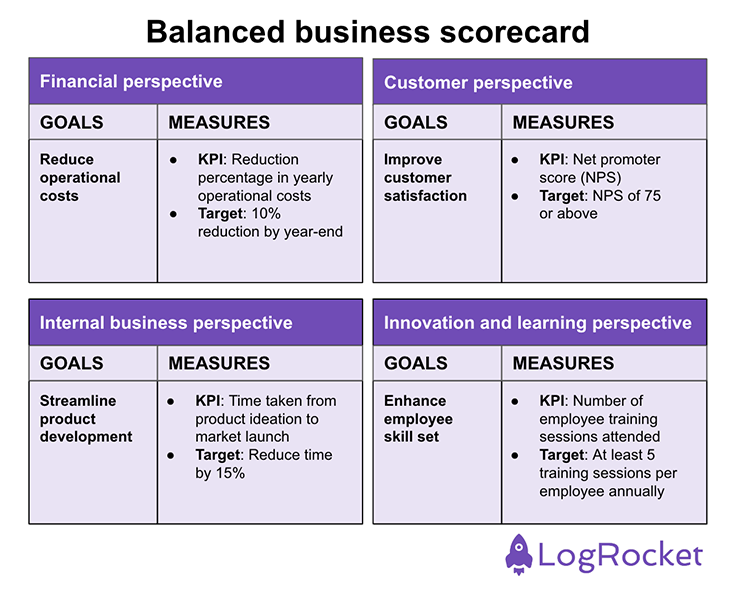Some managers may choose to focus on financial data to measure success. Others may focus on operational processes or customer satisfaction.

Instead of focusing on measuring only one aspect of a business, the balanced scorecard takes a holistic approach.
After all, a single measure can’t accurately represent all elements of a business. By using a scorecard, managers can get a balanced view of financial performance, operational processes, and customer satisfaction.
A balanced scorecard provides a comprehensive overview of how a company is performing currently. It takes into account finances, operational processes, customer satisfaction, and employee performance. Using a balanced scorecard can help managers find issues and improve business outcomes.
Ultimately, a balanced scorecard is a tool to help drive strategy, implement business actions, and improve financial performance.
A balanced scorecard seeks to uncover the answers to four questions:
Here are a few more benefits of using a balanced scorecard:
The balanced scorecard forces managers to choose only a few critical measures to determine performance. Many companies suffer from data overload and don’t know how to glean actionable insights from all of the data they collect. A balanced scorecard provides only key information, which helps you to avoid getting bogged down with too many numbers and figures.
Since balanced scorecards focus on critical data, it makes it easier to bring several elements into a single management report. A balanced scorecard contains everything a manager needs to make informed decisions. It can help managers focus on customer-oriented products, improve quality, and better internal processes.
Because operations, finances, and customer satisfaction are presented together, you’re forced to consider how each aspect affects the other. Sometimes, you might make a decision purely on financial data without considering that the result may lead to poorer internal processes and lower customer satisfaction. A balanced scorecard helps prevent this scenario because the data is available to you.
Implementing the balanced scorecard is hard to do without involving senior management. These people often have a better understanding of the company’s vision and processes. This improvement in communication often helps remove underlying assumptions about a company’s performance and goes beyond only focusing on financials.
Traditional performance management measures are designed to dictate what they want employees to do and gauge whether they are doing it. This approach doesn’t always work well in modern business because the standard way of doing things may become obsolete within a year.
Instead, the balanced scorecard puts vision and strategy at the center. It works to establish goals and pull employees toward a shared company vision. The balanced scorecard lets managers view interrelationships and lets employees determine the best course of action to meet company goals.
The balanced scorecard is comprised of four perspectives:
Each perspective focuses on a different aspect of an organization’s business strategy. Let’s dig a little deeper into what these perspectives provide to the balanced scorecard:
The financial perspective hones in on how the company looks to shareholders. Assuring shareholders they are receiving a return on their investment is crucial to the growth of the company. Executives may analyze data regarding the company’s financial performance and determine whether the company is profitable and make adjustments for improvement.
To sell your product or service, customers need to have a desire satisfied. The customer perspective determines customer satisfaction with the company’s current products and services. The more satisfied the customers are, the more likely they are to stay customers.
Data collected for this perspective can include customer feedback and competitor analysis. Based on the results, you can start to offer new products, promote high-satisfaction features, or improve product quality.
A proper analysis of business processes answers what you are good at doing and what you are bad at doing. Finding these answers can help you fix issues with bottlenecks, product delays, and other performance problems. It can also help you determine core competencies.
Essentially, this perspective aims to find opportunities to run at maximum efficiency.
Also known as the organizational capacity perspective, this area focuses on employees and their ability to produce work that improves and creates value for the company. It examines whether employees are receiving the training and resources they need to do their job. It also analyzes company culture and leadership performance.
Let’s look at a couple of real-world examples of balanced scorecards:
A company is looking for ways to improve its financial performance. However, it focuses purely on financial metrics to make these evaluations. This means they miss out on discovering how internal processes, customer satisfaction, and employee productivity can have an impact on its bottom line.
By taking a balanced scorecard approach, it notices an opportunity to use the excess capability to market its existing products to a new, relevant audience. This adds revenue to the company with only moderate expenses. Periodic financial reports prove that this new campaign improved sales and overall market share.
In this example, a company has made vast improvements in its delivery performance and overall product quality. But over the course of three years, the company didn’t have financial improvement and saw its value go down.
So what happened? By using the balanced scorecard, the company can notice that it failed to recognize the aspect of customer satisfaction and the demand for new products. Executives will need to rethink their strategy and consider the ways it can better meet the needs of their customers.
To make your own balance scorecard, follow these eight steps:
When everything is said and done, your balanced scorecard should look something like this:

Keep in mind, even the most efficient balanced scorecard doesn’t guarantee success. It only takes a company’s strategy and turns it into a measurable action plan. However, you can make better-informed decisions when it takes into account all variables of the scorecard instead of only focusing on one or two aspects.
A balanced scorecard creates value for the average employee. The measures are designed to motivate employees to fulfill the company’s strategic vision. While the balanced scorecard establishes goals, it leaves employees and managers to adopt behaviors and actions they deem appropriate to reach those goals.
This approach provides flexibility in a work environment that is constantly changing and evolving. Since the goals are created in a holistic manner, it will ideally lead to better financial performance as the company improves operations, customer satisfaction, and employee productivity.
Featured image source: IconScout
LogRocket identifies friction points in the user experience so you can make informed decisions about product and design changes that must happen to hit your goals.
With LogRocket, you can understand the scope of the issues affecting your product and prioritize the changes that need to be made. LogRocket simplifies workflows by allowing Engineering, Product, UX, and Design teams to work from the same data as you, eliminating any confusion about what needs to be done.
Get your teams on the same page — try LogRocket today.

Trey Courtney talks about his process for evaluating partnerships or acquisitions and how he successfully implements these initiatives.

Asma Syeda shares the importance of responsible AI and best practices for companies to ensure their AI technology remains ethical.

What hard skills do PMs need in 2025? Learn how AI tools can help you level up in SQL, Figma, A/B testing, and more.

Paul Weston talks about “quantifying the unquantifiable,” i.e., bringing in objective data for things that otherwise seem hard to measure.